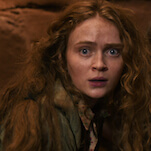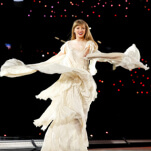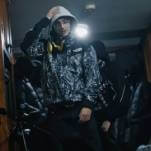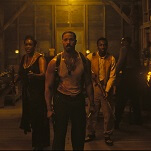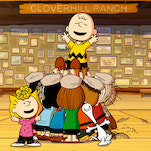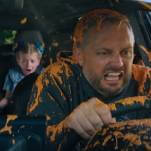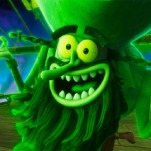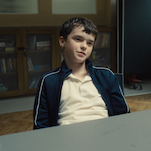Batman Returns is a relic of an age when disgusting monsters only ran for office in the movies
To really enjoy Batman Returns, you have to give yourself over to its triumphant silliness
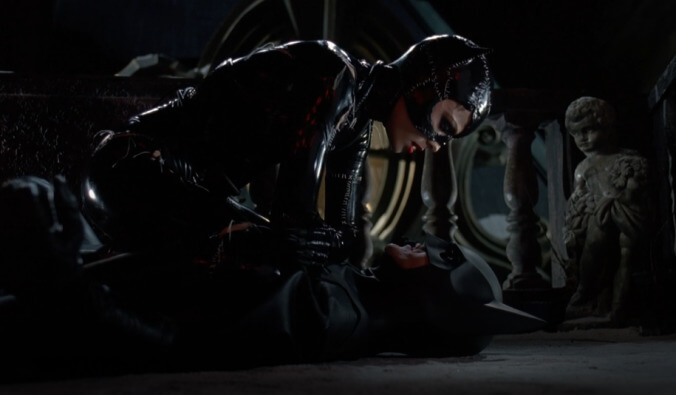
In honor of The Batman opening this week, we are rerunning some of our favorite features about the Caped Crusader. This article originally ran on March 23, 2018.
It seemed ridiculous in 1992: the idea of a misshapen, braying lunatic running for higher office while barely bothering to disguise his own painfully obvious-bordering-on-theatrical creepiness. These days, would anyone blink? In fact, the biggest difference between Batman Returns and our own impossible present-day reality is what happens when the candidate in question is caught saying evil shit on tape. In Batman Returns, Oswald Cobblepot lost the sympathy of the public so much that he didn’t even bother carrying on with his campaign! And Cobblepot was only running for mayor! Back when it came out, lots of people thought Batman Returns was too dark. Turns out it may not have been dark enough. If Donald Trump loses his bid for reelection in 2020 and our streets are suddenly full of penguins with missiles strapped to their backs, we can’t say Batman Returns didn’t warn us.
Of course, Batman Returns was dark. It was ridiculously dark. With his first Batman movie, Tim Burton found tremendous blockbuster success even as he introduced a Joker who bragged of being “the world’s first fully functioning homicide artist.” It can’t have been easy to up the ante from there. And yet Burton did it, introducing a drooling, deformed sex maniac of a villain whose final plan is to drown infants in toxic waste. When a character introduces the beautifully ridiculous Lex Luthorian plan of constructing a fake power plant that would steal and stockpile Gotham City’s electricity rather than generating it, he’s only the secondary villain, a total afterthought. And that’s not even getting into all the sex stuff.
And there’s so much sex stuff. As the Catwoman, Michelle Pfeiffer speaks almost entirely in double-entendre catchphrases. She dons a gleaming vinyl catsuit that Pfeiffer found almost impossible to wear. (I love how the character was supposed to make the costume by repurposing an old shiny raincoat while the real Pfeiffer had to be helped into it and then sprayed with silicon so that it would shine.) The costume is pure BDSM, something that is plenty obvious even before Pfeiffer cracks a whip for the first time. And both she and Danny DeVito’s penguin turn innuendo into high art. (My favorite line is DeVito, panting over an image consultant: “I’d like to fill her void! Teach her my French flipper trick!”)
And yet Burton managed to cram all this filthy nastiness into what was absolutely a children’s movie. To really enjoy Batman Returns, which is not exactly a difficult thing to do, you have to give yourself over to its triumphant silliness. Before a single word is spoken in the movie, we see an infant Penguin eat a cat as Pee-Wee Herman himself, Paul Reubens, takes a long, resigned drink. Selina Kyle, in her pre-Catwoman harried-secretary guise, has a giant pink-neon “hello there” sign in her apartment—something that could only exist so that she can, in her transformation, smash a couple of letters and turn it into “hell here.” When Christopher Walken’s Max Shreck meets his death by electrocution, he comes out looking like an Iron Maiden cover art. There is nothing about Batman Returns that even nods in the general direction of realism, and that’s why the movie is great.
Much more than the first Batman and possibly more than any other movie that Burton ever made, Batman Returns is driven by a sort of magical dreamlike logic. It takes place in a world where Oswald Cobblepot can be raised by actual zoo penguins without a single human being—not even a zookeeper—finding out. In this world, Cobblepot manages to organize, train, and costume an entire circus-themed gang of criminal marauders before his existence is anything more than a rumor to the surface-dwelling population. (The gang members are so ridiculous, in fact, that not even the evil clowns conjure memories of the previous movie’s Joker. Jack Nicholson’s Joker, a hurricane of hamminess in the first movie, is too grounded of a character to even make sense in Batman Returns.) In this same world, a herd of alley cats can resurrect a dead lady, and Catwoman’s whole thing about having nine lives goes from being mid-fight banter to an actual plot point; she helpfully keeps track of them for us.
Batman himself may be the least ridiculous character in Batman Returns, and the movie makes the wise decision to deemphasize him wherever possible. Michael Keaton reportedly told screenwriter Daniel Waters to cut most of his lines, and Keaton had the right idea. This Batman works best as a silent, glowering presence, as something for DeVito and Pfeiffer to play off of. He’s only barely in the first half-hour of the movie. I like how Burton introduces him motionless, staring off into nothing, as if he just shuts down whenever the Bat signal isn’t shining through his window. One thing that hasn’t aged especially well is how happily he kills people—lighting one evil clown on fire, strapping a bomb to another’s chest before pushing him into a hole while smiling. That’s just what was happening back when non-comics people were being encouraged to make comic-book movies. (There’s also a scene of Batman plowing through pedestrians in the Batmobile. It’s not his fault—Penguin is controlling the car via remote control—but that doesn’t make it much easier to watch post-Charlottesville.)


